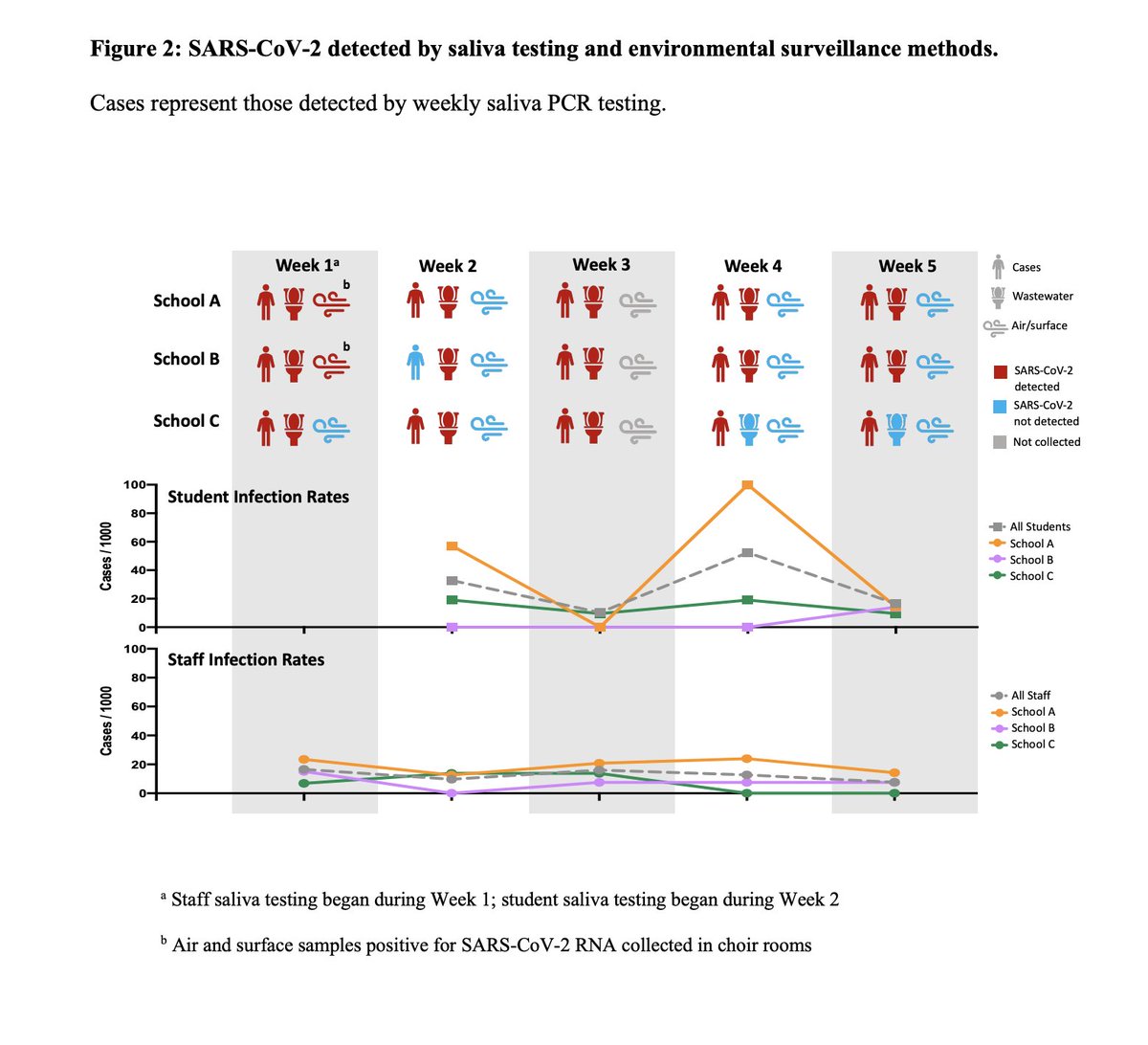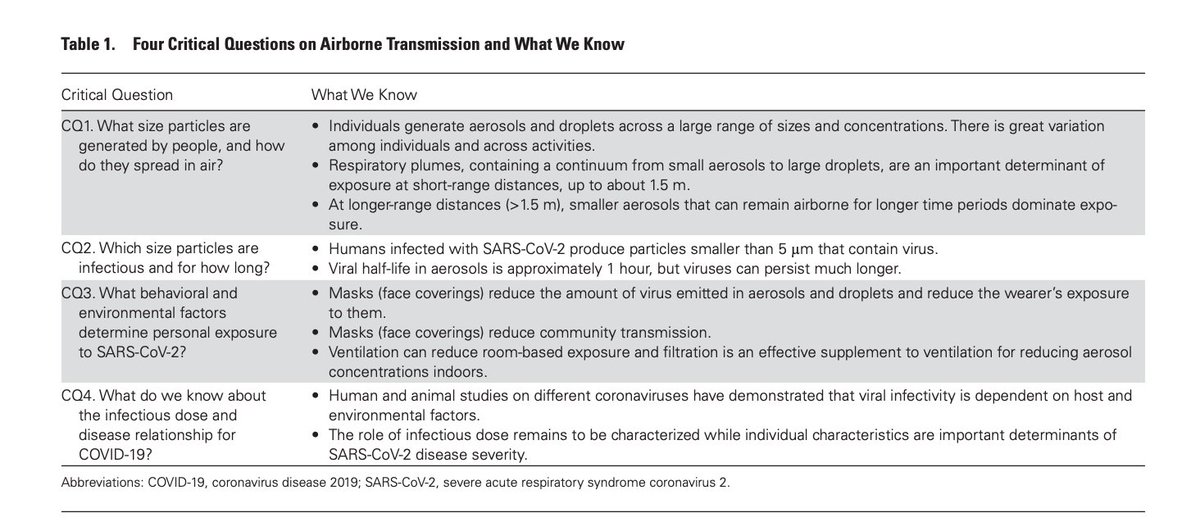
1/ A big myth of the "return to school buildings" debate is that COVID-19 magically🧙♀️ doesn't spread in kids.
A preprint from an Omaha pilot project debunks this bigly (again).
Another 🧵 with evidence for TESTING to detect and 🛑🦠. #SafetyIsVITAL
abcnews.go.com/Health/study-s…
A preprint from an Omaha pilot project debunks this bigly (again).
Another 🧵 with evidence for TESTING to detect and 🛑🦠. #SafetyIsVITAL
abcnews.go.com/Health/study-s…
https://twitter.com/rmc031/status/1384858432734437380
2/ University of Nebraska Medical Center found:
📌 Lots of asymptomatic COVID-19; testing caught cases MUCH higher than typical school reporting (self-reports and symptomatic).
📌 Staff: 2.5x more COVID
📌 Students: 6x more
📌 10x more 🦠 at school than in community stats
📌 Lots of asymptomatic COVID-19; testing caught cases MUCH higher than typical school reporting (self-reports and symptomatic).
📌 Staff: 2.5x more COVID
📌 Students: 6x more
📌 10x more 🦠 at school than in community stats

3/ Turns out schools may have missed up to 9 of 10 student cases and 7 of 10 staff cases — before better testing to detect and #StopTheSpread of COVID-19.
📌 District also mitigated risks:
✔️ hybrid
✔️ ¼ occupancy
✔️ 😷
✔️ 6 ft distancing
(HS & MS schools in study)
📌 District also mitigated risks:
✔️ hybrid
✔️ ¼ occupancy
✔️ 😷
✔️ 6 ft distancing
(HS & MS schools in study)

4/ The results are "proof of principle that this can be carried out successfully in an urban school district, among an otherwise underserved population, and we can make an immediate impact on the safety of our schools through rapid case identification," says Dr. @Jana_Broadhurst. 

5/ Better detection in schools could help end pandemic and protect underserved areas (w/limited healthcare access).
👉 Smart officials would use found kids' cases to stop outbreaks in neighborhoods, apartments, workplaces. School cases may indicate community spread & vice versa.
👉 Smart officials would use found kids' cases to stop outbreaks in neighborhoods, apartments, workplaces. School cases may indicate community spread & vice versa.

6/ Kinds of testing reviewed in this project were:
📌 PCR tests using saliva (adapted from Yale test) and were easy for kids to do.
(FYI APS vendor: @Resource_Path)
📌 Wastewater sampling
📌 Samples from air/surfaces (FYI: VIRUS FOUND in CHOIR ROOMS!)
medrxiv.org/content/10.110…
📌 PCR tests using saliva (adapted from Yale test) and were easy for kids to do.
(FYI APS vendor: @Resource_Path)
📌 Wastewater sampling
📌 Samples from air/surfaces (FYI: VIRUS FOUND in CHOIR ROOMS!)
medrxiv.org/content/10.110…

7/ With APS resuming indoor music this week, we have to note that students in choir were as much as 2.8x likely to test + for SARS-CoV-2.
Researchers collected VIRUS FLOATING IN AIR in choir rooms, and surmised that masks/measures weren't enough mitigation indoors. (Go outside!)
Researchers collected VIRUS FLOATING IN AIR in choir rooms, and surmised that masks/measures weren't enough mitigation indoors. (Go outside!)

8/ We kinda love acronyms, like "VITAL" safety measures... They came up with a cool name for this whole testing pilot endeavor:
Omaha Public Schools PROTECTS
Omaha Public Schools PROTECTS

9/ There are definite takeaways in this study for @APSVirginia on testing.
APS announced the start of free walk-up testing this week at three schools, but hasn't rolled out a broader, promised surveillance test plan — w/ 8 weeks left this year.
Fall?
apsva.us/school-year-20…
APS announced the start of free walk-up testing this week at three schools, but hasn't rolled out a broader, promised surveillance test plan — w/ 8 weeks left this year.
Fall?
apsva.us/school-year-20…
10/ APS should also look at other new research — now under peer review — on using wastewater and even dust samples (just send in a vacuum bag or a piece of carpet left out in a classroom!) to identify if COVID-19 is present — then target additional tests.
cdc.gov/coronavirus/20…
cdc.gov/coronavirus/20…
11/ Wastewater and dust tests are able to detect and alert that someone has COVID-19 :
📌 Bulk dust samples used to identify the presence of COVID-19 in a building:
msystems.asm.org/content/6/2/e0…
📌 Wastewater and floor dust samples used:
medrxiv.org/content/10.110…
📌 Bulk dust samples used to identify the presence of COVID-19 in a building:
msystems.asm.org/content/6/2/e0…
📌 Wastewater and floor dust samples used:
medrxiv.org/content/10.110…
12/ We found a local wastewater sampling lab that could check each APS school weekly for $280, using tips from the Omaha project.
But will all kids go 💩 at school? This study noted WW tests didn't always detect COVID-19 reliably, so they're refining protocols for schools.
But will all kids go 💩 at school? This study noted WW tests didn't always detect COVID-19 reliably, so they're refining protocols for schools.
13/ And in addition to all this, the state of Virginia and the Biden administration are pushing more tests out to schools! Can we participate in this pilot project, @BrianStockton19 / @APSReady / @Monique4APS ?!
safespotsyschools.com/icymi-vdh-pilo…
safespotsyschools.com/icymi-vdh-pilo…
14/ As far as kids not spreading COVID-19, a few more points in this monster thread.
First, a LOCAL serology study found children's cases were VASTLY underreported in NoVA and children had COVID-19 twice as much as adults! CDC found the same elsewhere.
First, a LOCAL serology study found children's cases were VASTLY underreported in NoVA and children had COVID-19 twice as much as adults! CDC found the same elsewhere.
https://twitter.com/smartrestartaps/status/1372592386627530752
14/ Early studies didn't try to identify all COVID cases, making risks harder to understand since the work was incomplete.
@rmc031 has covered the issue, and had a great piece about this and the RTS debate last month, with key research discussed.
newrepublic.com/article/161608…
@rmc031 has covered the issue, and had a great piece about this and the RTS debate last month, with key research discussed.
newrepublic.com/article/161608…
15/ We think a layered mitigation approach CAN make it safer to return kids to school buildings, but earlier studies were premature to declare schools virus-free zones w/o testing. In areas with greater COVID-19 spread, testing seems especially important!
jhsph.edu/covid-19/artic…
jhsph.edu/covid-19/artic…
16/ Another recent study of Atlanta schools (WITH testing) began to provide the kind of insights that would really help policy makers, such as impact of social distance, and what settings are most COVID-prone. (Indoor winter sports, ES with <3 feet, etc.)
https://twitter.com/smartrestartaps/status/1384549812440342529?s=20
17/ Other insights:
📌
📌
📌
📌
📌
📌
📌
📌 michiganradio.org/post/k-12-scho…
📌 smartrestartaps.org/round-up-of-ma…
📌
https://twitter.com/DrZoeHyde/status/1336612124835995648?s=20
📌
https://twitter.com/DrZoeHyde/status/1354348536368746501
📌
https://twitter.com/dgurdasani1/status/1346362159446577154
📌
https://twitter.com/Epi_D_Nique/status/1355229049262665728?s=20
📌
https://twitter.com/Theresa_Chapple/status/1356791250901475328
📌
https://twitter.com/Theresa_Chapple/status/1355193117348130818
📌
https://twitter.com/DrEricDing/status/1367448762025672704
📌 michiganradio.org/post/k-12-scho…
📌 smartrestartaps.org/round-up-of-ma…
Not enough mitigation for singing that is!
Another study from Atlanta featured via CDC recently ALSO a used testing and had good information in support of importance of distance and outdoor eating as a result of really trying to trace school transmission...
https://twitter.com/smartrestartaps/status/1373014902240129024?s=20
Here is a link to Mississippi serology report from CDC... kids undercounted by a factor of 12 by Sept. 2020! Similar finding to local study that found ⅔ of kids cases could be “silent spread“ and testing caught as little as 1 in 17 cases in Arlington.
https://twitter.com/fascinatorfun/status/1367578410659282945?s=20
• • •
Missing some Tweet in this thread? You can try to
force a refresh





